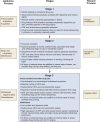The influence of stress on the transition from drug use to addiction
- PMID: 23584814
- PMCID: PMC3860459
The influence of stress on the transition from drug use to addiction
Abstract
Stress--that is, any type of stimulus that challenges the organism's normal internal balance--induces a physiologic response involving a variety of hormones and other signaling molecules that act on, among other organs, the brain. This stress response also can influence the progression of alcohol and other drug (AOD) addiction through various stages. For example, AODs can directly activate the stress response. In turn, certain stress hormones (i.e., glucocorticoids and corticotrophin-releasing factor) also act on the brain system that mediates the rewarding experiences associated with AOD use (i.e., the mesocorticolimbic dopamine system). Moreover, elevated glucocorticoid levels and stress increase AOD self-administration in certain animal models. During a later stage of the addiction process, in contrast, excessive and/or prolonged stress may impair the reward system, inducing heavier AOD use to maintain the rewarding experience. During the final stage of addiction, when the addicted person experiences withdrawal symptoms if no drug is consumed, chronic AOD use results in gross impairment of the normal stress response and other signaling mechanisms in the brain, resulting in a state of anxiety and internal stress. At this stage, people continue to use AODs mainly to relieve this negative-affect state.
Figures




References
-
- Aouizerate B, Ho A, Schluger JH, et al. Glucocorticoid negative feedback in methadone-maintained former heroin addicts with ongoing cocaine dependence: Dose-response to dexamethasone suppression. Addiction Biology. 2006;11(1):84–96. - PubMed
-
- Arzt E, Holsboer F. CRF signaling: Molecular specificity for drug targeting in the CNS. Trends in Pharmacologic Science. 2006;27(10):531–538. - PubMed
-
- Barrot M, Marinelli M, Abrous DN, et al. The dopaminergic hyper-responsiveness of the shell of the nucleus accumbens is hormone-dependent. European Journal of Neuroscience. 2000;12:973–979. - PubMed
-
- Becker HC, Lopez MF. Increased ethanol drinking after repeated chronic ethanol exposure and withdrawal experience in C57BL/6 mice. Alcoholism: Clinical and Experimental Research. 2004;28(12):1829–1838. - PubMed
Publication types
MeSH terms
LinkOut - more resources
Full Text Sources
Other Literature Sources
Medical
